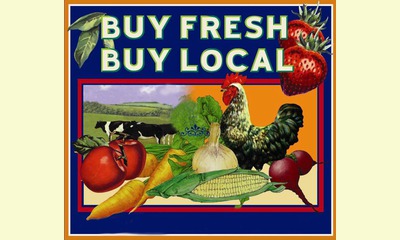|
|
Revitalizing agriculture: CSA movement builds communities, one farm at a time
an article by Craig Idlebrook, Hill Country Observer, USA
On a quiet road just off Route 23 is Indian Line
Farm [Egremont, Massachusetts], a place where
agricultural history was made. Not that you would
know it. The only marking to distinguish the farm
is a small sign on the mailbox. It was here in
1985 that farmers Robyn Van En and Jan Vander Tuin
joined with a group of area residents to form what
is believed to be the first community-supported
agriculture program in the United States. It was
simply named the CSA Garden of Great Barrington.
[CSA means Community-Supported Agriculture].

Image from Institute for Responsible Technology
click on photo to enlarge
For three years, local people paid in advance to
buy shares of the farm’s harvest, picking up
produce weekly throughout the growing season. It
didn’t always go smoothly, and there was even a
bitter split between the original CSA organizers
and Van En, but the local farm helped spark a
revolution in small-scale agriculture.
In the CSA model, which had been pioneered in
Europe before Van En imported it to Massachusetts,
a farm’s customers essentially share the risk and
provide the farmer with a measure of financial
protection from bad weather and insect pests.
Farms across the country, especially small-scale
vegetable producers, have since adopted the model,
and the concept has thrived in New England in
particular.
CSAs are helping the region’s small-farmers to stay
in business and earn a living, said Jennifer Conte,
marketing coordinator with Cornell Cooperative
Extension of Saratoga County. “They don’t have to
be a giant farm to compete,” Conte said.
But just how many farms are using the CSA model is
hard to figure. This fall, the U.S. Department of
Agriculture [USDA] will send out a questionnaire that,
among other things, will try to count the number
of CSA farms across the country. It’s the second
time the USDA has tried to take a head count of
CSA farms; the previous attempt sparked
controversy. CSA advocates argued that the
original USDA question was too vague and led to an
inaccurate count. Still, everyone agrees that the
number of CSA farms nationally will be in the
thousands.
Elizabeth Keen, who has worked the land at Indian
Line Farm since 1999, two years after Van En died
of an asthma attack, said she is awed by the idea
that the farm is where the CSA movement got
started. “It is pretty amazing when you think
about it,” she said. But Keen and her partner,
Alexander Thorp, don’t have too much time for
reverence. They’re busy raising five acres of
produce for their 140 CSA members. Although
members are welcome to visit the farm, Keen said
she’s just as happy that more people don’t make
the pilgrimage to see where the CSA movement got
its start. “I don’t want a lot of people stopping
by,” Keen said. “We have a lot of work to do. We
have been put on video more times than I care to
say.”
(This article is continued in the discussionboard).
|








|
DISCUSSION
There is no question yet associated with this article.
* * * * *
LATEST READER COMMENT:
(The following is continued from the main article listed above.)
Before her death in 1997, Van En worked actively to help other CSA farms get started around the country – up to 200 of them, by some estimates. Today, the nonprofit Robyn Van En Center at Wilson College in Pennsylvania continues that work by serving as a resource center for the CSA movement. In Massachusetts, the local BerkShares currency also honors Van En’s work by featuring her image on its 10 BerkShares notes.
After Van En’s death, most of the land at Indian Line Farm was transferred to The Nature Conservancy and a local land trust. The groups raised money to keep the farm in production and leased the property to Keen and Thorp.
This fall, thousands of farmers will receive the USDA’s questionnaire, asking about their farming practices, as part of the national agricultural census conducted every five years. Nestled among the dozens of boxes to check off is a brief question that asks farmers if they “marketed their products through a Community-Supported Agriculture arrangement.”
Although the form allows farmers to answer the question by checking yes and no, figuring out how to count the number of community-supported agriculture programs in the United States may not be that simple.
The same question, asked in the USDA’s 2007 survey, prompted the agency to declare in 2009 that 12,549 farms nationally were involved in CSAs -- thousands more than previously thought. Although the findings made it seem as though the CSA movement was growing rapidly, many people in the movement challenged the USDA’s estimate, calling it wildly distorted. . ...more.

|
|









